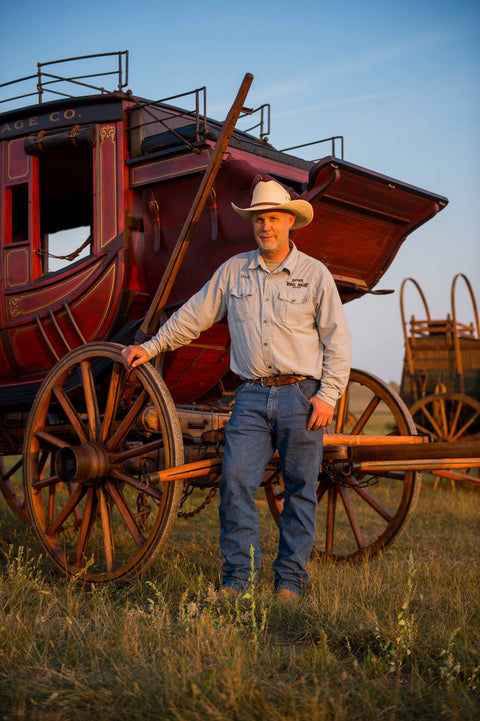
This Wagonmaker Just Keeps Rolling Along
Who says living in the past doesn’t pay? Doug Hansen has turned a youthful passion for old-world craftsmanship into an internationally renowned business still rooted on family land in Letcher, S.D. Hansen Wheel & Wagon Shop has restored and built wagons and stagecoaches for museums, theme parks, film and TV productions, collectors, reenactors and people who just plain like to travel by wagon. Working in new and old buildings—the shop’s finishing area is in a former railroad depot—the Hansen team has built wagons and camp gear for such popular productions as Dances With Wolves and 1883 , as well as the forthcoming Kevin Costner film Horizons. Hansen has also worked on stagecoaches and wagons for Wells Fargo, Disney, Knotts Berry Farm and Budweiser’s signature Clydesdales. Word has certainly gotten out, as the shop’s history-minded customers include clients in France, Norway, Sweden, Denmark, Japan and Taiwan—anywhere people celebrate the heritage of fine craftsmanship.
What inspired you to work on wagons?
My family gets a lot of credit, because my dad had a nice shop, my mom had a leather shop, and we had horses. My mother is a saddlemaker. My grandfather was a teamster and had worked in his uncle’s blacksmith shop. I was intrigued with old-world craftsmanship as a kid. A wheel needed restoration, so I undertook that. Pretty soon my mother was buying buggies at antique auctions, and I restored them. All of a sudden my hobby got out of control, and I made it a business. We are building those vehicles I’m passionate about.
Would you rather restore/rebuild or start from scratch?
When doing restoration, you’re usually just cleaning up, profiling. But in a replication, you have to build everything, and there are specific hardwoods for different components. A spoke is hickory. A felloe [rim] is white oak. The hub is elm. A reach [bearing shaft] is hickory. All your panel wood is yellow poplar. One of the challenges is finding the stock. In today’s hardwood industry most stock is used for kitchen cabinets and furniture. It’s thinner stock. The wagon industry no longer exists, so the heavy stock and specific species are harder to find. We often find we have to custom saw and custom dry, and it’s a long-drawn-out process.
Building a replica is a lot like being a sculptor. You have to rely on your eye and your hand to recreate that. You are sculpting a horse-drawn vehicle, be it a buckboard or a stagecoach. You are sculpting thousands of components. That historical accuracy of the horse-drawn era is form over function. They have to look good. They have to work.
What type of vehicle do you most like to restore?
The stagecoach is my passion. It is the most complex. The leather thoroughbraces, the pumpkin- shaped vehicle—it is a complex vehicle of industry and artistry. My aptitude is the mechanical, the engineering, and then the artsy side of it. I can easily comprehend the engineering, and I appreciate the design. Like any historical trade, it takes a certain amount of time to understand. You have to get it right historically. It’s not your design; you are replicating a period.
How do you define your role?
I’m the visionary. I carry chalk in my pocket, and I draw pictures on the ground or a bench, then work with the actual sculptor, the craftsman.
How do you find or train employees?
It’s not our equipment that builds wagons—we don’t have cookie cutters. It’s our craftsmen, their dedication, skill and passion. All of them have aptitude. Nobody comes aboard as a wainwright or a wheelwright. We bring them on, train them, immerse them in our world. We work as a team—wheelwright, wainwright, blacksmith, coach maker, painter, trimmer and ornamentor. We take wood, iron, pigments, textiles and leather, and poof! you have a vehicle. One day you roll it out, critique it and say, “What can we do better next time?” We strive to be as proficient as the men back in the 1800s. They had all the knowledge. We’re still uncovering lost knowledge. We will never fully understand the process.
What historical insights have you gleaned?
There’s a difference between a historian who lives it and one who writes it. I can read about a vehicle, I can look at it, but I don’t understand it as much as when I build it and drive it.
How do you differ from period Old West craftsmen?
They were forward engineering to meet a need. We are reverse engineering. What we do is a little bit like archaeology. We need to uncover tidbits of information as well as the obstacles. America was built by the teamsters who had the fortitude, ingenuity and desire to get past obstacles.
Have any projects left you wondering, Why did I agree to do this one?
Can of worms projects we didn’t mean to put that much money into. We try to figure out in advance, Will this be too complex? Then you open the can of worms. All things are obtainable, but not always obtainable by the budget.
Do any projects stand out?
I enjoy doing conservation and restoration. We’ve learned so much from vehicles with historical content. Now we understand the design, textiles, leathers, pigments and the engineering specifics of the wood species. There’s so much information when you get a historic vehicle like the last stagecoach we worked on, from Annisquam, Ma. It’s like opening a volume of encyclopedias.
The best museum projects would have to be the Oregon Trail replicas we’ve built. It’s an obscure wagon. There were thousands of them, but the emigrants used them up like old trucks. Those are fun. We’ve built covered wagons for trail interpretive centers across the West. Other vehicles that come to mind are the stagecoaches. We’ve restored Wells Fargo coaches that had original content in them—signatures, dates. We even found an upholsterer’s tool. They’re all fascinating.
